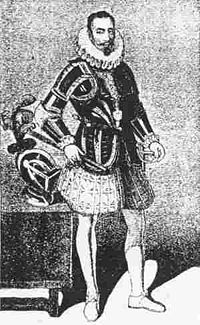- Donal Cam O'Sullivan Beare
-
Donal Cam O'Sullivan Beare, Prince of Beare, 1st Count of Berehaven (Irish: Domhnall Cam Ó Súilleabháin Bhéara) (1561–1618) was the last independent ruler of the O'Sullivan Beara sept, and thus the last O'Sullivan Beare, a Gaelic princely title, in the southwest of Ireland during the early seventeenth century, when the English were attempting to secure their rule over the whole island.
Contents
Early life
Donal's father was killed in 1563, but his son was considered to be too young to inherit and the clan leadership passed to the chief's surviving brother Owen, who was confirmed by English authorities in Dublin with the title Lord of Beare and Bantry. In order to consolidate his position, Owen accepted the authority of Queen Elizabeth I of England and was knighted. In 1587 Donal asserted his own claim to leadership of the clan, petitioning Dublin to put aside Owen's appointment with a claim derived from English laws based on absolute male primogeniture. These laws did not recognise age as relevant to inheritance rights. Keen to extend English legal authority over Ireland, the Dublin commission accepted Donal's claim. He now became "the O'Sullivan Beare".
Nine Years War
By 1600 Munster had been devastated by battle, and the Gaelic clans lost over half a million acres (4,000 km²) of land to settlers from England following the defeat of the Desmond Rebellions.[citation needed]
In the lead up to the Nine Years' War O'Sullivan kept his distance from the rebel cause, but in time he joined a confederation of Gaelic chiefs led by Hugh O'Neill, Earl of Tyrone and Hugh Roe O'Donnell of Ulster. Conflict had broken out in 1594, and O'Neill secured support from Philip II of Spain. The Spanish sent a force under the command of Don Juan D'Aquilla in 1601. O'Sullivan wrote to the Spanish king in submission to his authority, but the letter was intercepted by the English. In early 1602 the allied Irish and Spanish forces met the English at the Battle of Kinsale and were defeated.
O'Sullivan resolved to continue the struggle by taking control of the castle of Dunboy. In 1603 English forces attacked Dunboy and the castle fell after a vicious siege. The entire company of defenders was killed in combat or executed.[1]
O'Sullivan's march
Donal himself was absent from the siege, having travelled to the north of the island for a conference with Hugh O'Neill. His letter to Philip left him with little hope of a pardon from the English, and he continued the fight with guerilla tactics.
He was eventually forced to gather up his remaining followers, including women and children, and set off for the north, on a 250-mile march which he and his people completed in 14 days. He fought a long rearguard action across Ireland, during which the much larger English force fought him all the way, as did rival Irish leaders. The march is one of the most poignant in Irish history and was marked by enormous suffering as the fleeing and starving O'Sullivans sought food from an already decimated Irish countryside in winter, often resulting in hostility, such as from the Mac Egans at Redwood Castle in Tipperary. O'Sullivan marched through Aughrim, where he raided villages for food and met with local resistance. He was barred entrance to Glinsk castle and led his refugees further north. On their arrival at the O'Rourke's castle in Leitrim on January 4th 1603, only 35 of the original 1,000 remained. Many had died in battles or from exposure and hunger, and others had settled along the route. In Leitrim, O'Sullivan sought to join with other northern chiefs to fight the English and organised a force to this end, but resistance ended when Hugh O'Neill, 2nd Earl of Tyrone signed the Treaty of Mellifont. O'Sullivan, like other member of the Gaelic nobility of Ireland who fled, sought exile, making his escape to Spain by ship .
Exile
When he left Ireland, Cornelius O'Driscoll and other Irish knights helped him and his clan. In Spain O'Sullivan was welcomed by King Philip III. His princely status was reconfirmed, and he received a commission as an imperial general. His cousin, Pilib Ó Súilleabháin Bhéara, was particularly important in this regard and his 1618 disquisition in Latin, A Briefe Relation of Ireland and the diversity of Irish in the same was particularly influential.[2]
In 1618, O'Sullivan was murdered just as he was leaving mass in the Plaza Santo Domingo in Madrid. The murderer was John Bathe, a young Englishman who had been disfigured in a duel by the prince's nephew, on account of some arguments between Bathe and O'Sullivan; it is also said that the man was a spy on behalf the English Crown.
O'Sullivan enjoyed a wide reputation, which helped to open doors for later soldiers from his line. About 165 years later, one descendant, John Sullivan, served as a general in the American Revolution.[citation needed]
See also
References
Categories:- 1561 births
- 1613 deaths
- Flight of the Earls
- Irish chieftains
- Irish diaspora politicians
- Irish expatriates in Spain
- People of Elizabethan Ireland
- Wild Geese
- Medieval Gaels
- People from County Cork
- 16th-century Irish people
- 17th-century Irish people
- Irish soldiers in the Spanish Army
- Irish emigrants to Spain
Wikimedia Foundation. 2010.

